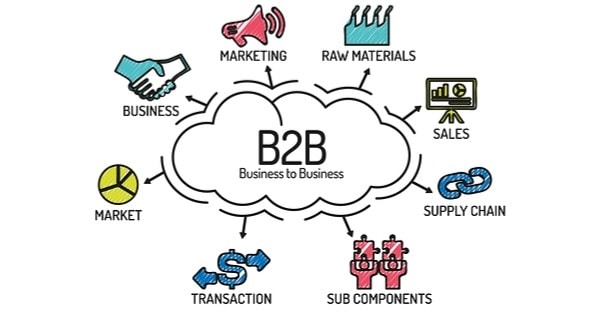B2B stands for business-to-business. The term B2B is primarily used in the business model. It represents that the manufactured product by one company directly deals with the other company. This means that businesses primarily provide their products or services first to other businesses, not directly to consumers.

Importance of B2B
B2B is an essential aspect of modern commerce, playing a critical role in the global economy. Here are some reasons why B2B is important −
Drives Economic Growth
B2B transactions account for a significant portion of economic activity worldwide. Businesses depend on each other to source materials, manufacture products, and deliver goods and services.
Creates Employment Opportunities
B2B transactions lead to the creation of jobs and the growth of businesses, which in turn drive employment opportunities in various sectors of the economy.
Facilitates Innovation
B2B collaborations and partnerships can lead to the development new products, technologies, and solutions that can transform entire industries and drive innovation.
Enables Cost Savings
B2B transactions can help businesses save costs by streamlining supply chain management, negotiating better prices, and leveraging economies of scale.
Builds Long-term Relationships
B2B relationships often involve long-term partnerships that can be mutually beneficial and lead to sustainable growth and success for both parties.
Brief Details about B2B
B2B (Business-to-Business) involves transactions and interactions between businesses. Key points include:
- Target Audience: B2B engages professionals and decision-makers within organizations.
- Products/Services: It covers a wide range, from raw materials to services.
- Longer Sales Cycles: Complex decision processes are common.
- Relationship-Centric: Building trust and long-term partnerships is vital.
- Customization: Tailoring offerings to meet specific business needs.
- Higher Volume/Value: Involves significant transactions.
- Content Marketing: Utilizes informative content for informed decisions.
- Networking: Industry-specific events foster connections.
- Payment Terms: May include negotiated terms.
- Regulations/Compliance: Adherence to industry standards.
- Global Reach: Transactions occur worldwide.
- Technology Integration: Use of tech solutions for efficiency.
Examples of B2B Transactions
There are various types of B2B transactions, depending on the industry and the specific products or services involved. Here are some common examples −
- Raw Material Procurement: A manufacturer purchasing raw materials from a supplier to produce its products.
- Wholesale Purchases: A retailer purchasing goods in bulk from a wholesaler for resale in its stores.
Distribution Agreements: A distributor partnering with a manufacturer to distribute its products to retailers.
- Professional Services: A law firm providing legal services to a corporation or another law firm.
- Software as a Service (SaaS): A company purchasing cloud-based software services from a provider for use in its operations.
- Maintenance and Repair Services: An industrial machinery company contracts with a service provider for maintenance and repair services.
- Supply Chain Management: A logistics company partnering with a transportation provider to manage its supply chain operations.
- Joint Ventures: Two or more companies collaborating to develop and market a new product or service.
B2B Marketing
B2B marketing refers to the process of promoting and selling products or services from one business to another. Effective B2B marketing strategies focus on building long-term relationships with customers and delivering value through personalized solutions that address specific business needs. Here are some key aspects of B2B marketing:
1. Targeted Marketing
B2B marketers need to identify the right target audience for their products or services, based on factors such as industry, company size, and job role.
2. Content Marketing
Providing high-quality content such as whitepapers, case studies, and webinars can establish a business as an expert in its field and build trust with potential customers.
3. Account-based marketing (ABM)
ABM is a targeted approach that focuses on personalized marketing to specific accounts or customers, with the goal of building stronger relationships and generating higher-quality leads.
4. Lead Generation and Nurturing
B2B marketers need to generate leads and nurture them through the sales funnel with targeted messaging and relevant content.
5. Relationship-building
B2B marketing should aim to build long-term relationships with customers, through ongoing communication, customer support, and personalized solutions that address specific business needs.
6. Measurement and Analytics
Measuring the effectiveness of B2B marketing campaigns and tracking metrics such as ROI, conversion rates, and customer lifetime value is crucial to optimizing marketing efforts and improving outcomes.
Challenges in B2B
- The B2B (Business-to-Business) surroundings offer its very own unique set of demanding situations that groups must navigate as a way to be successful. One of the primary demanding situations is the complexity of B2B transactions. These generally contain multiple selection makers in the company.
- Another significant challenge is customization. B2B customers have diverse and specific needs, requiring suppliers to tailor their products or services to meet these requirements accurately. This customization can strain resources and logistics, but satisfying client demands is essential.
- Additionally, B2B organizations must contend with evolving regulations and compliance standards, especially in highly regulated industries. Staying up-to-date and ensuring adherence to these standards can be time-consuming and costly.
Conclusion
In the hastily evolving panorama of B2B advertising, one factor is clear: the techniques and methods that worked the previous day won’t be powerful the next day. To achieve B2B advertising and marketing, agencies must be agile, adaptable, and constantly prepared to include new technology and trends.
Throughout this manual, we’ve explored the important thing components of B2B advertising, from the know-how of your target market to leveraging content material marketing, e-mail campaigns, social media, search engine marketing, and paid marketing. We’ve delved into the significance of courting building, analytics, and the use of advanced advertising equipment and software programs.
FAQs About B2B
B2B stands for “Business-to-Business,” referring to transactions and interactions between businesses, rather than between businesses and individual consumers.
B2B involves business transactions between companies, while B2C (Business-to-Consumer) involves transactions between businesses and individual consumers.
Common examples include the sale of raw materials, office supplies, software, machinery, consulting services, and marketing services from one business to another.
Challenges include complex decision-making processes, customization to meet specific business needs, regulatory compliance, global operations, B2B marketing nuances, and adapting to evolving technology.
Related posts:
- AMC Full Form: Benefits, Components, Needs, Advantage
- ORS Full Form: Dehydration, Myths, Flavors, Varieties & Facts
- PCC Full Form: Importance, Types, Application Process
- PAN Full Form: Legal Provisions, Regulations,
- BRB Full Form: Productive, Routine, Distractions
- MCD Full From: Introduction, Responsibility, Challenges
- CT Scan Full Form: Scans, price, Advantages
- USA Full Form: History, Economics,Technology, culture




















